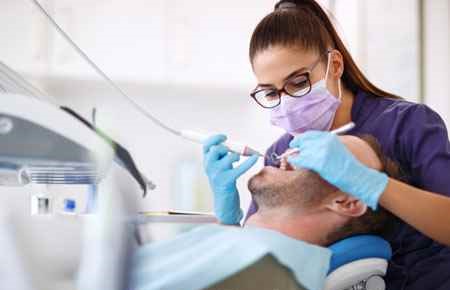
Dental Assistant
Summary
Dental assistants provide patient care, take x rays, keep records, and schedule appointments.
What they do
Dental assistants have many tasks, including patient care, recordkeeping, and appointment scheduling. Their duties vary by state and by the dentists’ offices in which they work.
Dental assistants typically do the following:
- Ensure that patients are comfortable in the dental chair
- Prepare patients and the work area for treatments and procedures
- Sterilize dental instruments
- Hand instruments to dentists during procedures
- Dry patients’ mouths using suction hoses and other equipment
- Instruct patients in proper oral hygiene
- Process x rays and complete lab tasks, under the direction of a dentist
- Keep records of dental treatments
- Schedule patient appointments
- Work with patients on billing and payment
Dental assistants often spend much of their day working closely with patients and dentists. For example, dental assistants might take a patient’s medical history, blood pressure, and pulse before a procedure; explain what will be done; and talk to patients about oral care. They help dentists during a procedure by passing instruments and holding equipment such as suction hoses, matrix bands, and dental curing lights. Other tasks include preparing the treatment room and making sure that instruments and equipment are sterile. Dental assistants also may document the procedure that is done and schedule follow-up appointments.
Some dental assistants are specially trained to take x rays of teeth and the surrounding areas. They place a protective apron over patients’ chest and lap, position the x-ray machine, place the x-ray sensor or film in patients’ mouths, and take the x rays. Afterward, dental assistants ensure that the images are clear.
Assistants who perform lab tasks, such as taking impressions of a patient’s teeth, work under the direction of a dentist. They may prepare materials for dental impressions or temporary crowns.
Each state regulates the scope of practice for dental assistants. Some states let dental assistants polish teeth to remove stains and plaque from the enamel or apply sealants, fluoride, or topical anesthetic.
Work Environment
Dental assistants work under the supervision of dentists and work closely with dental hygienists in their day-to-day activities.
Dental assistants wear safety glasses, surgical masks, protective clothing, and gloves to protect themselves and patients from infectious diseases. They also must follow safety procedures to minimize risks associated with x-ray machines.
How to become a Dental Assistant
here are several possible paths to becoming a dental assistant. Some states require assistants to graduate from an accredited program and pass an exam. In other states, there are no formal educational requirements, and dental assistants learn through on-the-job training.
Some states require dental assistants to graduate from an accredited program and pass an exam. Most programs are offered by community colleges, although they also may be offered by vocational or technical schools.
Many dental assisting programs take about 1 year to complete and lead to a certificate or diploma. Programs that last 2 years are less common and lead to an associate’s degree. The Commission on Dental Accreditation (CODA), part of the American Dental Association, accredits about 250 dental assisting training programs.
Accredited programs include classroom and laboratory work. Students learn about teeth, gums, jaws, and other areas that dentists work on and the instruments that dentists use. These programs also include supervised practical experience.
High school students interested in a career as a dental assistant should take courses in anatomy, biology, and chemistry.
Pay
The median annual wage for dental assistants was $40,080 in May 2019. The median wage is the wage at which half the workers in an occupation earned more than that amount and half earned less. The lowest 10 percent earned less than $27,980, and the highest 10 percent earned more than $56,930.
Job Outlook
Employment of dental assistants is projected to grow 7 percent from 2019 to 2029, faster than the average for all occupations. Ongoing research linking oral health and general health will continue to increase the demand for preventive dental services. Dentists will continue to hire dental assistants to complete routine tasks, allowing dentists to work more efficiently. As dental practices grow, more dental assistants will be needed.
Similar Job Titles
Certified Dental Assistant (CDA), Certified Registered Dental Assistant, Dental Assistant (DA), Expanded Duty Dental Assistant (EDDA), Expanded Function Dental Assistant, Oral Surgery Assistant, Orthodontic Assistant (Ortho Assistant), Orthodontic Technician, Registered Dental Assistant (RDA), Surgical Dental Assistant
Related Occupations
Dental Hygienist, Radiologic Technologist, Surgical Technologist, Neurodiagnostic Technologist, Endoscopy Technician
More Information
The trade associations listed below represent organizations made up of people (members) who work and promote advancement in the field. Members are very interested in telling others about their work and about careers in those areas. As well, trade associations provide opportunities for organizational networking and learning more about the field’s trends and directions.
- American Dental Assistants Association
- American Dental Association
- Dental Assisting National Board
- National Dental Association
Magazines and Publications
Dental assistants help make dentists more efficient, and patients more comfortable. They perform a blend of direct patient care and administrative duties. Dental assistants prepare the dental exam room, sterilizing and setting up equipment. During appointments, dental assistants may take x-rays, hand dentists instruments, keep patients’ mouths dry, and teach patients about proper oral hygiene. On the administrative side, they maintain patient records, schedule appointments, and work with patients on billing and payment. Essential skills for dental assistants include detail orientation, finger dexterity, listening, and organization. Almost all dental assistants work in dentists’ offices. They wear safety glasses, surgical masks, and gloves, and follow safety procedures to protect themselves and patients. About one-third of dental assistants work part time. Some work evenings or weekends. Requirements to enter the field differ: some states require graduation from an accredited program, and licensure or certification. Other states have no formal educational requirements, and assistants learn their duties on-the-job.
Content retrieved from: US Bureau of Labor Statistics-OOH www.bls.gov/ooh,
CareerOneStop www.careeronestop.org, O*Net Online www.onetonline.org

